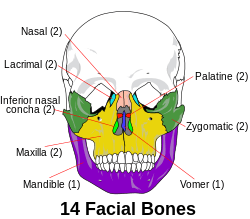Facial skeleton
| Facial bones | |
|---|---|
 The fourteen bones that form the human facial skeleton. | |
 The fourteen facial bones. (Neurocranium is shown in semi-transparent.)
| |
| Details | |
| Part of | Face, skeleton |
| Identifiers | |
| Latin | ossa faciei, ossa facialia |
| TA | A02.1.00.008 |
| FMA | 53673 |
The facial skeleton, viscerocranium, or splanchnocranium consists of a part of the skull that is derived from the pharyngeal arches. The facial bones are the bones of the anterior and lower skull. The rest of the skull is the neurocranium.
Structure
For the human skull, most sources always include these fourteen bones in their lists of facial bones:[1][2]
- Inferior nasal concha (2)
- Lacrimal bones (2)
- Mandible
- Maxilla (2)
- Nasal bones (2)
- Palatine bones (2)
- Vomer
- Zygomatic bones (2)
Variations
The hyoid bone is sometimes included. The ethmoid bone (or a part of it) and also the sphenoid bone are sometimes included, but otherwise considered part of the neurocranium. Some sources describe the maxilla's left and right parts as two bones. Likewise, the palatine bone is also sometimes described as two bones.
Textbooks differ as to what bones to include in the facial skeleton. Some textbooks make a strict distinction between bones of the neurocranium and viscerocranium, based on the embryological origins of the bones. Other textbooks tend to include all the bones that can be seen in a frontal aspect of the human skull; consequently they include bones such as the frontal bone.[3]
Development
The viscerocranium is derived from the neural crest cells (also responsible for the development of the neurocranium, teeth and adrenal medulla) or from the sclerotome, which derives from the somite block of the mesoderm. As with the neurocranium, in Chondricthyes and other cartilaginous vertebrates, they are not replaced via endochondral ossification. In tetrapods, such as amphibians and reptiles, the columella connecting to the tympanum is derived from the splanchnocranium. In mammals, the splanchnocranium derives the bones of the middle ear, the malleus, the incus and stapes.
Variation in craniofacial form between humans is largely due to differing patterns of biological inheritance. Cross-analysis of osteological variables and genome-wide SNPs has identified specific genes, which control this craniofacial development. Of these genes, DCHS2, RUNX2, GLI3, PAX1 and PAX3 were found to determine nasal morphology, whereas EDAR impacts chin protrusion.[4]
Additional images
- Human facial skeleton. Front view.
 Human skull. Lateral view.
Human skull. Lateral view. Facial bones and neurocranium (labeled as "Brain case").
Facial bones and neurocranium (labeled as "Brain case").
See also
References
- ↑ Skeletal System / Divisions of the Skeleton
- ↑ facial+bone - Definition from Merriam-Webster's Medical Dictionary
- ↑ Such differences will affect the total bone count of the facial skeleton, but these are only differences in how to classify and/or describe the anatomy of the skull, and that regardless of what classification/description is preferred, the anatomy remains the same.
- ↑ Adhikari, K., Fuentes-Guajardo, M., Quinto-Sánchez, M., Mendoza-Revilla, J., Chacón-Duque, J. C., Acuña-Alonzo, V., Gómez-Valdés, J. (2016). "A genome-wide association scan implicates DCHS2, RUNX2, GLI3, PAX1 and EDAR in human facial variation". Nature communications. 7. Retrieved 20 October 2016.
External links
| Wikimedia Commons has media related to Facial skeleton. |